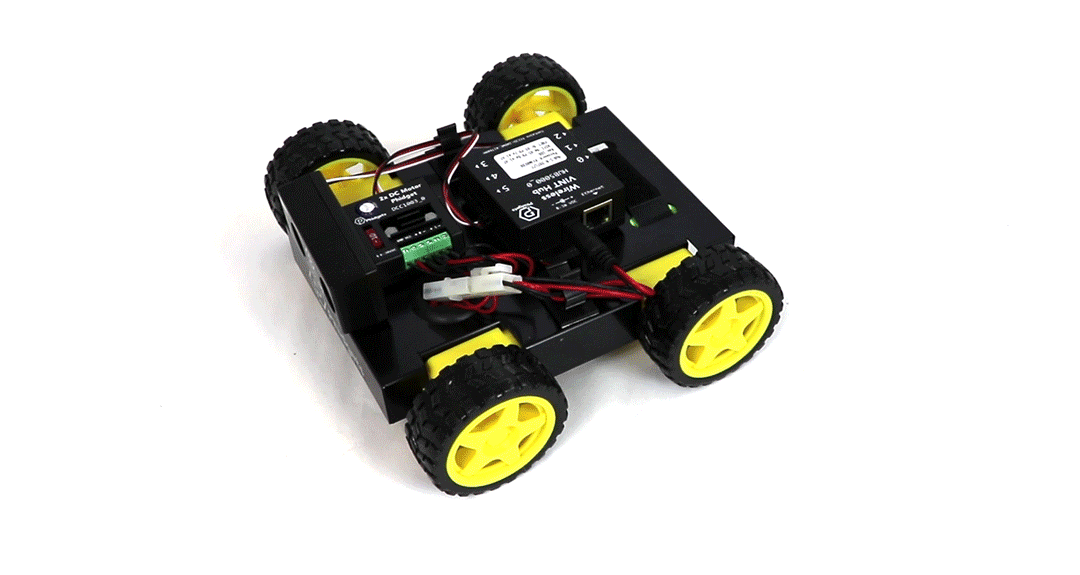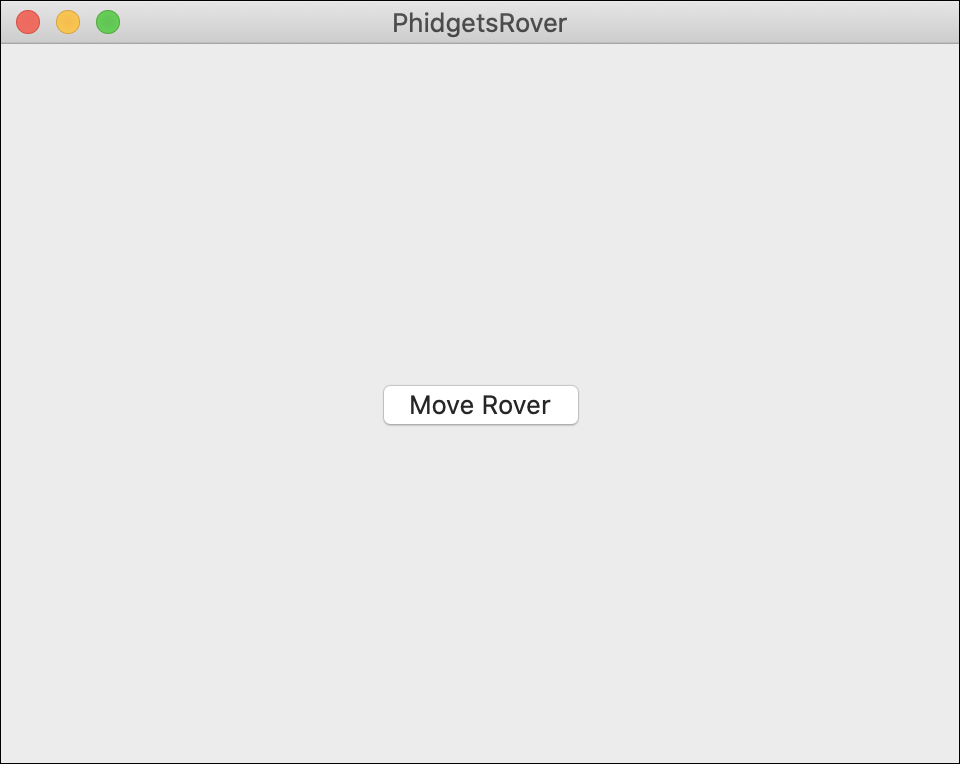In this step, you will learn how to turn your rover.

You can keep working from your PhidgetsRover project in this step. Add the following code to your file and run it.
Write code (Java)
Not your programming language? Set your preferences so we can display relevant code examples
package phidgetsrover;
//Add Phidgets Library
import com.phidget22.*;
public class PhidgetsRover {
public static void main(String[] args) throws Exception {
//Connect to wireless rover
Net.addServer("", "192.168.100.1", 5661, "", 0);
//Create
DCMotor leftMotors = new DCMotor();
DCMotor rightMotors = new DCMotor();
//Address
leftMotors.setChannel(0);
rightMotors.setChannel(1);
//Open
leftMotors.open(5000);
rightMotors.open(5000);
//Turn in one direction
leftMotors.setTargetVelocity(1);
rightMotors.setTargetVelocity(-1);
//Wait for 2 second
Thread.sleep(2000);
//Stop motors
leftMotors.setTargetVelocity(0);
rightMotors.setTargetVelocity(0);
}
}
//Add Phidgets Library
import com.phidget22.*;
public class PhidgetsRover {
public static void main(String[] args) throws Exception {
//Connect to wireless rover
Net.addServer("", "192.168.100.1", 5661, "", 0);
//Create
DCMotor leftMotors = new DCMotor();
DCMotor rightMotors = new DCMotor();
//Address
leftMotors.setChannel(0);
rightMotors.setChannel(1);
//Open
leftMotors.open(5000);
rightMotors.open(5000);
//Turn in one direction
leftMotors.setTargetVelocity(1);
rightMotors.setTargetVelocity(-1);
//Wait for 2 second
Thread.sleep(2000);
//Stop motors
leftMotors.setTargetVelocity(0);
rightMotors.setTargetVelocity(0);
}
}
//Add Phidgets Library
import com.phidget22.*;
//Define
DCMotor leftMotors;
DCMotor rightMotors;
void setup(){
try{
//Connect to wireless rover
Net.addServer("","192.168.100.1", 5661,"",0);
//Create
leftMotors = new DCMotor();
rightMotors = new DCMotor();
//Address
leftMotors.setChannel(0);
rightMotors.setChannel(1);
//Open
leftMotors.open(5000);
rightMotors.open(5000);
}catch(Exception e){
//Handle Exceptions
e.printStackTrace();
}
}
void draw(){
try{
//Turn in one direction
leftMotors.setTargetVelocity(1);
rightMotors.setTargetVelocity(-1);
//Wait for 2 seconds
delay(2000);
//Stop motors
leftMotors.setTargetVelocity(0);
rightMotors.setTargetVelocity(0);
//Only execute draw once for this example
noLoop();
}catch(Exception e){
//Handle Exceptions
e.printStackTrace();
}
}
Write code (Python)
Not your programming language? Set your preferences so we can display relevant code examples
#Add Phidgets library
from Phidget22.Phidget import *
from Phidget22.Net import *
from Phidget22.Devices.DCMotor import *
#Required for sleep statement
import time
#Connect to your wireless rover
Net.addServer("", "192.168.100.1", 5661, "", 0)
#Create
leftMotors = DCMotor()
rightMotors = DCMotor()
#Address
leftMotors.setChannel(0)
rightMotors.setChannel(1)
#Open
leftMotors.openWaitForAttachment(5000)
rightMotors.openWaitForAttachment(5000)
#Turn in one direction
leftMotors.setTargetVelocity(1)
rightMotors.setTargetVelocity(-1)
#Wait for 2 seconds
time.sleep(2)
#Stop motors
leftMotors.setTargetVelocity(0)
rightMotors.setTargetVelocity(0)
Write code (C#)
Not your programming language? Set your preferences so we can display relevant code examples
//Add Phidgets Library
using Phidget22;
namespace PhidgetsRover{
class Program{
static void Main(string[] args){
//Connect to wireless rover
Net.AddServer("", "192.168.100.1", 5661, "", 0);
//Create
DCMotor leftMotors = new DCMotor();
DCMotor rightMotors = new DCMotor();
//Address
leftMotors.Channel = 0;
rightMotors.Channel = 1;
//Open
leftMotors.Open(5000);
rightMotors.Open(5000);
//Turn in one direction
leftMotors.TargetVelocity = 1;
rightMotors.TargetVelocity = -1;
//Wait for 2 seconds
System.Threading.Thread.Sleep(2000);
//Stop motors
leftMotors.TargetVelocity = 0;
rightMotors.TargetVelocity = 0;
}
}
}
Write code (Swift)
Not your programming language? Set your preferences so we can display relevant code examples
NOTE: the code below assumes you've created a single button and linked it to an IBAction named moveRover

import Cocoa
//Add Phidgets Library
import Phidget22Swift
class ViewController: NSViewController {
//Create
let leftMotors = DCMotor()
let rightMotors = DCMotor()
override func viewDidLoad() {
super.viewDidLoad()
do{
//Connect to wireless rover
try Net.addServer(serverName: "", address: "192.168.100.1", port: 5661, flags: 0)
//Address
try leftMotors.setChannel(0)
try rightMotors.setChannel(1)
//Open
try leftMotors.open()
try rightMotors.open()
}catch{
print(error)
}
}
@IBAction func moveRover(_ sender: Any) {
do{
//Turn in one direction
try leftMotors.setTargetVelocity(1.0)
try rightMotors.setTargetVelocity(-1.0)
//Wait for 2 seconds
sleep(2)
//Stop motors
try leftMotors.setTargetVelocity(0.0)
try rightMotors.setTargetVelocity(0.0)
}catch{
print(error)
}
}
}
Practice
- Try turning your rover in the opposite direction.
- Try moving forwards, turning 180°, and moving back to your starting position.














